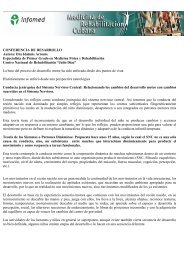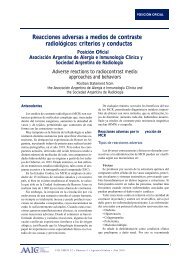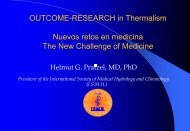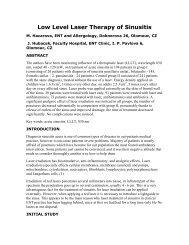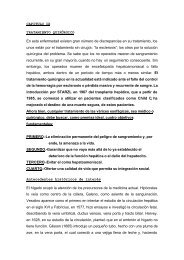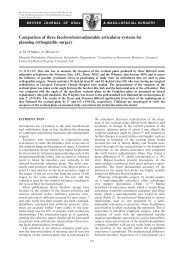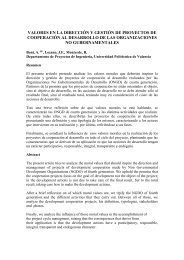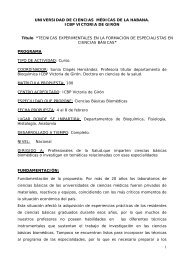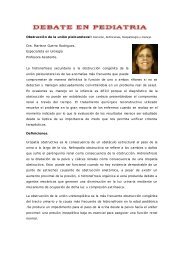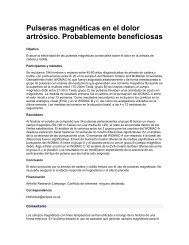pharmacology of medicinal plants and natural products
pharmacology of medicinal plants and natural products
pharmacology of medicinal plants and natural products
You also want an ePaper? Increase the reach of your titles
YUMPU automatically turns print PDFs into web optimized ePapers that Google loves.
S102<br />
S. A. DAHANUKAR et al.,<br />
given as pre-treatment) also influenced the effects.<br />
Of these <strong>plants</strong> Emblica <strong>of</strong>ficinalis strengthened the<br />
defense mechanisms against free radical damage<br />
induced during stress. The effect <strong>of</strong> Emblica <strong>of</strong>ficinalis<br />
appeared to depend on the ability <strong>of</strong> target tissues to<br />
synthesize prostagl<strong>and</strong>ins. On the other h<strong>and</strong>,<br />
gastroprotective effect <strong>of</strong> Tinospora cordifolia was<br />
probably mediated through a predominantly immunostimulant<br />
mechanism as the protection was found<br />
to disappear on blocking the macrophage function.<br />
In normal mice, high doses <strong>of</strong> Tinospora cordifolia<br />
significantly increased apoptosis in bone marrow<br />
cells. The therapeutic doses (100-200 mg/kg) were<br />
devoid <strong>of</strong> such effect. However, at the same therapeutic<br />
doses, it induced apoptosis in malignant cells,<br />
but protected the normal bone marrow from apoptosis<br />
induced by cyclophosphamide. This variable effect<br />
<strong>of</strong> Tinospora cordifolia (<strong>of</strong> increasing or decreasing<br />
apoptosis) depending on the stressor (either cancer<br />
or cyclophosphamide) as well as the cell type (S-<br />
180 or bone marrow cells) suggests its true potential<br />
as an adaptogen. It is <strong>of</strong> further interest to note that<br />
Tinospora cordifolia increases the bone marrow proliferative<br />
fractions at 100 <strong>and</strong> 200 mg/kg doses thus<br />
leading to leucocytosis. If the dose is increased,<br />
apoptosis is observed <strong>and</strong> the leucocytosis is blunted.<br />
This apparent paradox may be due to its effects on<br />
c-myc, a gene that causes both proliferation as well<br />
as induces apoptosis depending on the environment.<br />
It is exciting thus to hypothesise that Tinospora<br />
cordifolia may be producing some <strong>of</strong> its effects via<br />
activation <strong>of</strong> c-myc <strong>and</strong> inducing ‘genotypic’ adaptation.<br />
Ocimum sanctum, known to have antistress properties,<br />
was recently studied by Sembulingam et al, 220<br />
for its antistress effects against a different type <strong>of</strong><br />
stress i.e. noise pollution, in rats. The ethanolic extract<br />
<strong>of</strong> Ocimum sanctum reversed the changes in<br />
plasma levels <strong>of</strong> corticosterone induced by exposure<br />
to both acute <strong>and</strong> chronic noise stress, indicating the<br />
antistress property <strong>of</strong> the plant against noise.<br />
Studies have been reported in the literature to explore<br />
the possible mechanisms responsible for<br />
adaptogenic effect. For example, Panax ginseng did<br />
not modify brain <strong>and</strong> hypothalamic 5HT levels in unstressed<br />
rats, however, it attenuated restraint stress<br />
induced elevation <strong>of</strong> 5HT levels 221 .<br />
19. Nutraceutics<br />
This is an emerging field <strong>of</strong> therapy. As we come to<br />
the end <strong>of</strong> this millennium, more <strong>and</strong> more people<br />
are getting health conscious <strong>and</strong> are looking at dietary<br />
substances for preventive or curative effects.<br />
Support towards this line <strong>of</strong> thinking from the scientific<br />
field is described in the following paragraphs.<br />
19.1. Indian spinach (Beta vulgaris)<br />
Dietary consumption <strong>of</strong> green vegetables has been<br />
associated with protection against mutagenic <strong>and</strong><br />
clastogenic activity <strong>of</strong> genotoxicants. Chlorophyll,<br />
present in all green <strong>plants</strong>, has been suggested to<br />
be the principal factor involved. Sarkar et al, 222 compared<br />
the clastogenic or anticlastogenic effects <strong>of</strong><br />
crude aqueous extract <strong>of</strong> leaf <strong>of</strong> Indian spinach, (Beta<br />
vulgaris L. var. benghalensis Hort.) <strong>and</strong> equivalent<br />
amounts <strong>of</strong> chlorophyll extracted from leaf, purified<br />
chlorophyll <strong>and</strong> chlorophyllin (a sodium copper derivative).<br />
After treatment for 7 days, the mice were<br />
administered potassium dichromate, a known metallic<br />
clastogen <strong>and</strong> sacrificed 24 hrs later. Cytogenetic<br />
end points were chromosomal aberrations <strong>and</strong><br />
damaged cells. Results showed that both crude leaf<br />
extract <strong>and</strong> chlorophyllin were nonclastogenic <strong>and</strong><br />
reduced the clastogenic effects <strong>of</strong> potassium dichromate.<br />
However, chlorophyll was clastogenic. The protective<br />
effect <strong>of</strong> the crude leaf extract was attributed<br />
to the total effect <strong>of</strong> the interaction between the different<br />
components within the leaf extract, thus neutralising<br />
the clastogenic effects <strong>of</strong> chlorophyll.<br />
19.2. Karela (Momordia charantia)<br />
Substitution <strong>of</strong> groundnut oil with palmolein in cereal<br />
based lactovegetarian diets provides about 30% <strong>of</strong><br />
total fat calories, doubles the saturated fatty acids<br />
<strong>and</strong> reduces by half the linoleic acid content. The<br />
hypoglycemic activity <strong>of</strong> the alcoholic extract <strong>of</strong> the<br />
pulp <strong>of</strong> Momordia charantia (Karela) was evaluated<br />
in 3 experimental models <strong>of</strong> diabetes. In the normal<br />
glucose primed rat model, it decreased plasma glucose<br />
that was not accompanied by increase in insulin<br />
secretion. No evidence <strong>of</strong> tachyphylaxis to its effects<br />
on repeated dosing was found. In streptozotocin<br />
induced diabetic rats, it improved glucose tolerance<br />
<strong>and</strong> significantly reduced plasma glucose.<br />
The extract also increased the rate <strong>of</strong> glycogen<br />
synthesis from 14 C- glucose by 4-5 fold in the liver <strong>of</strong>




